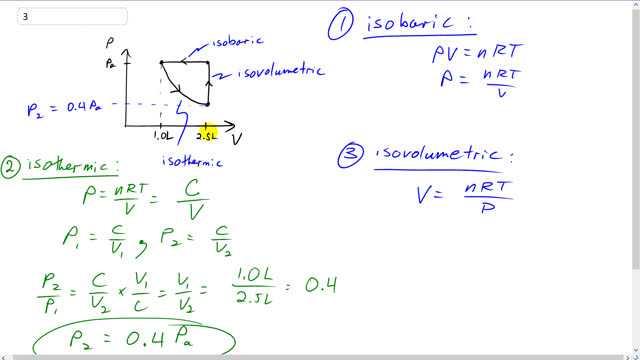
Sketch a PV diagram of the following process: 2.5 L of ideal gas at atmospheric pressure is cooled at constant pressure to a volume of 1.0 L, and then expanded isothermally back to 2.5 L, whereupon the pressure is increased a constant volume until the original pressure is reached.

In order to watch this solution you need to have a subscription.
This is Giancoli Answers with Mr. Dychko. So the gas starts in this state here at some pressure. P1, which is atmospheric pressure and it has an Isobaric transition from volume of two and a half liters to one liter and Isobaric means the pressure is constant. And so we have a straight horizontal line and it's kind of helpful to think about what's happening to the gas. This stuff I'm going to show you here is not necessary for drawing the graph. The graph and Isobaric transition is really straightforward. It’s just a straight horizontal line because pressure is constant. but it's useful to think about this ideal gas law and we can solve for pressure and divide both sides by V and pressure is nRT over V. And in order for pressure to be constant as the volume is decreasing, as you see here from two and a half liters to one, the temperature has to increase or decrease by the same factor in order for pressure to be constant. So it's interesting to know that the temperature must also be changing. This graph doesn't display temperature, but because it's only a two dimensional graph it can only, you know, plot two things at once, pressure and volume in this case. But we do know behind the scenes, the temperature has to decrease by the same factor. So when volume decreases by 50 percent, then temperature has to also decrease by 50 percent so that the 50 percent cancels, so to speak, so that this this ratio stays the same. And then once you get to a volume of one liter, there's gonna be Isothermic expansion as the volume goes back to two and a half liters and it's going to follow this curve here. And the shape of that curve is a y equals one over x type of shape, a reciprocal graph. And the reason for that is that because it's an Isotherm, when you solve for pressure here, it's nRT over V. And being an Isotherm that means this numerator is constant. So temperature is not going to change. And so the only thing that's going to change is the denominator V. And so this is some constant divided by some variable. And so this is a Y equals one over X shaped graph. And so as volume increases, this fraction will decrease in the same way that one quarter is smaller than one half. As you increase the denominator of the fraction, you decrease the quotient. And so that's why you see that pressure is decreasing as the volume is increasing. And then the question is, what's the y coordinate at this bottom point? We should put that on there and it's 0.4 times atmospheric pressure. We know that Pressure One to begin with is going to be some constant divided by V1 and Pressure Two at the end here is going to be the same constant because it's the same temperature and the same number of moles divided by this new volume V2. And we can now divide these two pressures P2 divided by P1. That's gonna be C over V2 multiplied by the reciprocal of P1. Instead of dividing by P1, we will multiply by reciprocals, these constants cancel and we have V1 over V2. And so that's one liter where it starts with here and then it transitions to two and a half litres. So V1 is 1 and divide that by V2 which two and a half and that's 0.4. So P2 is a 0.4 times P1 and P1 is Pa atmospheric pressure. So this, end pressure here is gonna be 0.4 times the atmospheric pressure. And then we have the Isovolumetric transition from this point to this point. And so that means the volume stays constant and it's going to be just a vertical line, then pressure is changing. And it's interesting to notice that temperature also will be changing by the same factor that the pressure changes. So if you increase pressure by two times, then the temperature also has to increase by two times in order for this ratio to be constant and have the volume be constant.